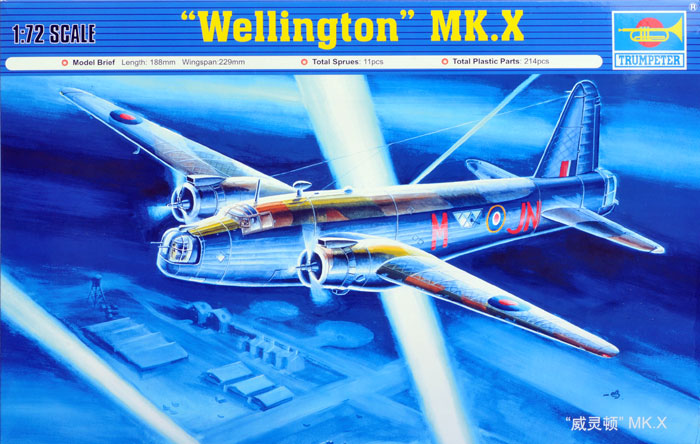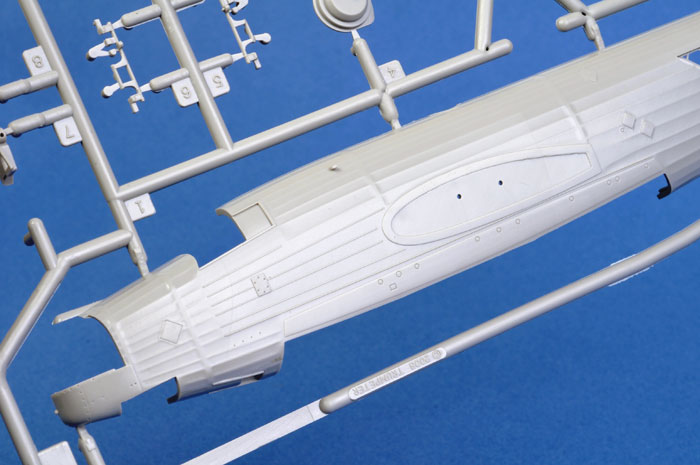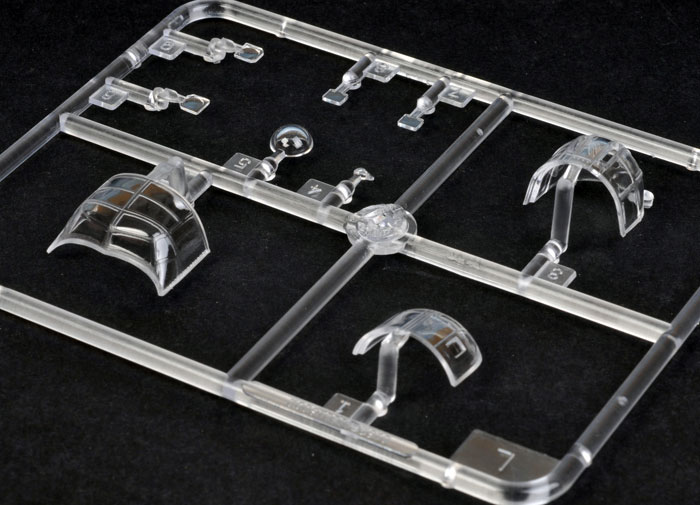Vickers Wellington Mk. X

Trumpeter, 1/72 scale
S
u m m a r y
|
| Catalogue Number and Description: |
Trumpeter Item No. 01628 Wellington Mk. X |
| Scale: |
1/72 |
| Contents and Media: |
197 light grey plastic parts on eleven sprues, 15 clear plastic parts on two sprues and decals for 2 aircraft plus a 5 page fold-out instruction sheet with parts plan and 16 build diagrams. A separate sheet with paint and decal placement guide is also supplied. A small amount of history is on the box side. |
| Price: |
Around AUD$46.95, distributed in Australia by J.B. Wholesalers
Available through specialist hobby shops worldwide |
| Review Type: |
FirstLook |
| Advantages: |
Perfect moulding; very high level of detail; accurate; crisp clear transparent parts |
| Disadvantages: |
Surface detail will be too heavy for some modellers’ tastes; no bombs or provision for open doors; virtually unusable decals. |
| Recommendation: |
I would still have to say this is an excellent kit. The MPM kits also have faults and apart from the surface detail, which I believe most modellers could live with, the rest of my criticisms are only areas where they could have done better. |
Reviewed by Glen Porter

Trumpeter's 1/72 scale Wellington Mk.X is available online from
Squadron
The Wellington Mk. X was based on the Mk.III which, itself, was the first to carry the Hercules engines and four gun rear turret.
The steel Geodetic structure of the Mk. III was replaced by aluminium in the Mk. X along with uprated Hercules power plants which allowed a higher take-off weight.
Some of the externally visible modifications included longer intake scoops on top of the engines, a slight change in shape of the tail-planes with a different horn and mass-balance shape and mass-balance added to the fin on some later aircraft.
The Mk.X was the last bomber version of the Wellington, and the most produced with around 3,800 being delivered.
Having two MPM Wellington kits, a Mk. Ic and a Mk. III, I couldn't help but compare them. Both Trumpeter and MPM kits have their advantages and drawbacks. The first thing you will notice is the artwork on the boxes. MPM's is quite attractive while Trumpeter's is trashy. Fortunately, this does not reflect the high quality of the plastic inside.
In my opinion, the biggest problem with the Trumpeter kits, including their 1/48 scale offerings, is their surface detail. Some modellers considered the MPM kits were overdone but they are quite tame compared to these. I'm told that they look okay when painted but a quick rub with some Wet & Dry would not hurt but care would have to be taken not to erase some of the wanted detail.

The other area of concern is the bomb bay. Not really a problem so much as something they could have done better. After-all, the MPM kits don't have any bomb-bay at all. The roof and side-walls are nicely detailed and there's even mounts for some weapons but the doors, with good detail on the inside, is in only one piece where as it should be in five if you wanted to show them open. I have no doubt that some resin company will soon come up with a suitable set and hopefully a set of bombs to go with them. This is odd, considering the rest of the fuselage is actually crammed with the stuff, even the crew's in-flight toilet, most of which will disappear once the fuselage halves are closed.
The 4+ book on the Wellington, my main reference for this review, says that some Mk. Xs had the side windows above the wings. You don't get that option in this kit but I would rather that than what MPM give you in their Mk. III, inserts which, when fitted, will have seems around the edges that will be impossible to erase without damaging the other detail surrounding them.

Talking of side windows, I also like the way Trumpeter have done the triangular waist windows. Unlike MPM, they have left the Geodetic frames, visible through the windows, moulded as part of the fuselage in grey plastic and you simply glue the windows over it. In the MPM kit you have to paint the frames onto the inside of the clear plastic.
The fin/rudder are separate in the Trumpeter kit and you get the option of early or late versions and the same with the tail-planes but the instructions and paint/decal sheet only show the early ones being used. However, the option is there.
Trumpeter has gone to a lot of trouble to make the ailerons positionable so why didn't they do it with the elevators and rudder? Again, not really a fault.
The wheel wells are more detailed and have more parts than you get from MPM as are the turrets although with them there is still room for super-detailing if required.
You get the option of Rotol prop with big spinners or de Havilland without spinners but again the instructions tell you to use the Rotol items only.
Transparencies are all well moulded and very clear. The turrets look like they will be easier to construct than MPM's.

Decals have never been Trumpeter's strong point and these are no exception. Two options are offered, an RAF Mk. X, LN385/ JN-M from 150 Squadron in Italy, 1943 and a French Air Force aircraft, LN374/M, 1946. The red in the RAF markings is way too bright, almost crimson and nowhere near brick-red. The blue in the RAF roundels looks okay but on the fin flash it's the same as the French blue which is too light for British markings. Upper wing roundels on the British aircraft are non standard with a bigger than usual red centre and this may be correct as I believe some Wellies did fly with these kind of markings.

However, LN385/JN-M is one of the featured aircraft in the 4+ book and it shows the standard roundels and I would be inclined to trust 4+ before Trumpeter in this area.
Despite my criticisms above, I would still have to say this is an excellent kit. The MPM kits also have faults and apart from the surface detail, which I believe most modellers could live with, the rest of my criticisms are only areas where they could have done better.
I like the MPM Wellingtons but I believe this offering from Trumpeter is superior mainly because of the higher level of detail.
Text and Images Copyright © 2009 by Glen Porter
Page Created 6 March, 2009
Last updated 29 February, 2008
Back to HyperScale Main Page
|
